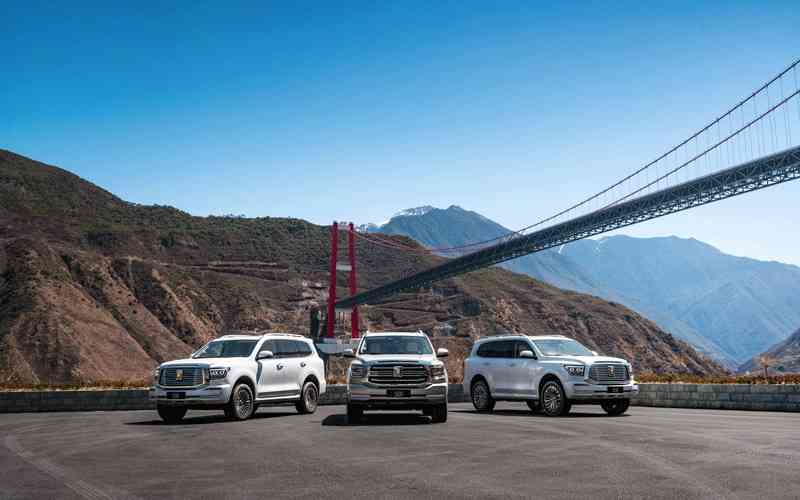
Unquestionably, Chinese auto=makers have become more and more dominant on roads locally and globally in recent years. Chinese brands, which were previously limited to the Chinese domestic market, are now competing with industry titans in a variety of regions, including Southeast Asia, Africa, Europe, and even Latin America.Due to a combination of strategic innovation, competitive pricing, and a deep awareness of evolving consumer expectations, this shift represents a significant change in the global automotive landscape.In Zimbabwe, Chinese automotive brands are rapidly gaining traction, driven by their affordability, suitability for local conditions, and increasing availability. Brands like Great Wall Motors, Chery, BYD, JAC Motors, and Foton are popular for their budget-friendly passenger cars, SUVs, and commercial vehicles, which cater to the needs of both individuals and businesses.Chinese trucks and buses have also become staples in the construction, mining, and public transport sectors, often favouring them for their cost-effectiveness compared to Western and Japanese alternatives. Strong economic ties between Zimbabwe and China, including Chinese investments in infrastructure and favourable trade agreements, further support this growth. Where the Chinese work on local projects, they will bring in lorries from China.Most, if not all, of the tippers and buses that roam our roads are Chinese. Zimbabwe has a high demand for the GWM Tank 500 SUV.Innovation at an affordable priceChinese automakers' ability to blend affordability with state-of-the-art technology is one of the most convincing factors driving their increasing success. At a lot less than their Western or Japanese counterparts, Chinese automakers like BYD, Geely, and Great Wall Motors are selling cars with cutting-edge features like electric drivetrains, autonomous driving, and sophisticated infotainment systems.China's cost-effective manufacturing techniques, economies of scale, and government subsidies for the electric vehicle (EV) industry are the main causes of this pricing advantage. For example, BYD quickly emerged as a global leader in the EV market and used its expertise in battery manufacturing to provide competitively priced electric vehicles with remarkable performance and range. Many times, consumers can purchase cars with features like integrated smart systems, fast charging, and long-range batteries for a fraction of the price of comparable Western models. The revolution of EVsChinese automakers, especially those that specialise in electric vehicles, have greatly benefited from the global trend towards sustainability. Chinese brands have established themselves as powerful players as governments around the world implement stricter emissions regulations and provide incentives for the adoption of electric vehicles. China's government has made significant investments in R&D and infrastructure after recognising the potential of the electric vehicle industry, which has given domestic businesses a competitive advantage. Chinese EV manufacturers have also profited from their early advantage in the production of batteries, which are essential to electric cars. One of the biggest battery manufacturers in the world, CATL supplies global behemoths like Tesla in addition to Chinese auto-makers. Because of this vertical integration, Chinese auto-makers are able to keep production costs under control and provide cars at a lower cost than many of their competitors.GlobalisationThe aggressive global expansion strategy of Chinese auto-makers is another factor contributing to their success. Chinese auto=makers have targeted emerging markets in Africa, Southeast Asia, and Latin America, in contrast to South Korean or Japanese auto-makers, who first concentrated on capturing the U.S. market. Due to growing middle-class incomes and a growing need for reasonably priced cars, these areas, which are frequently neglected by Western automakers, offer growth prospects. Additionally, Chinese businesses have demonstrated a readiness to adapt to regional markets. They frequently invest in assembly plants, form joint ventures with regional businesses, and modify their cars to satisfy particular customer demands and legal specifications. Great Wall Motors has constructed assembly plants in countries like Thailand and Brazil to cut costs, speed up delivery, and build goodwill with local governments. Quality, brand imageIt is crucial to remember that, over the past ten years, Chinese auto-makers have significantly improved the calibre and reliability of their automobiles. In the early 2000s, people often dismissed Chinese auto-mobiles as subpar, low-cost substitutes. Today, companies such as NIO, XPeng, and Geely are garnering praise for their performance, safety, and design. Some Chinese automobiles are even surpassing the performance of more established brands in safety tests and customer satisfaction surveys. To change perceptions, Chinese auto-makers have also made significant investments in marketing and branding. Partnerships with foreign firms, high-profile sponsorships, and collaborations with renowned design studios have elevated their international profiles. For example, Geely's position as a reliable international player has been strengthened by its acquisition of Volvo Automobiles and its ownership of Daimler, the parent company of Mercedes-Benz. Obstacles for rivalsFor established automakers, the quick ascent of Chinese brands presents serious obstacles. Businesses in the US, Japan, and Europe frequently find it difficult to match their Chinese counterparts' low prices and technological superiority. Chinese automobiles' low cost and growing reputation for high quality are forcing competitors to reevaluate their strategies. Higher labour costs, stricter environmental laws, and outdated systems also hinder Western automakers' ability to change courses as quickly as their Chinese competitors.Although some companies, such as Tesla and Volkswagen, have advanced in the EV market, they still have to contend with fierce competition from Chinese companies, who frequently innovate and adjust to market demands more quickly. The road aheadFor Chinese auto-makers, the future is not without challenges, though. Geopolitical tensions, particularly those between the United States and China, may hinder their entry into important markets.Furthermore, heightened scrutiny of Chinese automobiles may result from growing worries about data security and supply chain origins. Chinese auto-makers will need to step up their efforts in quality control, transparency, and cooperation with foreign partners to overcome these obstacles. The growing competition in the global EV market is another possible obstacle. Chinese brands will need to keep coming up with new ideas as more competitors enter the market. The global switch to electric vehicles is still in its infancy, and it is unclear how the market will develop over the ensuing ten years. Final thoughtThe emergence of Chinese auto-makers is evidence of the nation's capacity for innovation, adaptation, and international competition. Chinese brands have drawn consumer attention and changed the automotive industry by providing high-quality, reasonably priced, and environmentally friendly automobiles. Despite the obstacles they still face, the momentum they have established suggests their longevity.Chinese auto-makers have established themselves as pioneers of a new era of mobility in a world that is increasingly characterised by technological innovation and environmental consciousness.One of the most intriguing stories to follow in the upcoming years is whether they can continue to dominate despite increasing competition.But for now, it is safe to say that Chinese companies are redefining roads rather than merely occupying them. My opinion is by 2030 they will be dominating the world motor industry.andrew@muzamhindo.com






